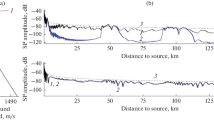Abstract—
It is established that the interference invariant can be calculated not only by analyzing the frequency and spatial distribution of the intensity field but also by studying the phase-gradient field. It is found that the interference structure of the intensity field and the field of value inverse to the phase gradient (effective phase velocity) can be described by identical dependences, based on the use of invariant. It is shown that, in contrast to shallow water, which is characterized by relative stability of invariant values, the interference invariant in deep water changes significantly with variation in distance. In the shadow zone, with detectors and sources located at real depths (less than 400 m), the interference invariant can be described by an analytical dependence, which is in essence affected by only the water depth and distance; it is affected by neither sound frequency, nor source depth, nor detector depth and is only slightly affected by the characteristics of speed-of-sound vertical profile. Hence, the thus obtained analytical dependence can be referred to as invariant.




Similar content being viewed by others
REFERENCES
S. D. Chuprov, “Interference structure of a sound field in a layered ocean,” in Ocean Acoustics, Current Status, Ed. by L. M. Brekhovskikh and I. B. Andreyeva (Nauka, Moscow, 1982), pp. 71–91 [in Russian].
L. M. Brekhovskikh and Yu. P. Lysanov, Theoretical Foundations of Ocean Acoustics (Nauka, Moscow, 2007) [in Russian].
K. L. Cockrell and H. Schmidt, “A modal Wentzel–Kramers–Brillouin approach to calculating the waveguide invariant for non-ideal waveguides,” J. Acoust. Soc. Am. 130 (1), 72–83 (2011). https://doi.org/10.1121/1.3592236
G. A. Grachev, “On theory of acoustic field invariants in layered waveguides,” Acoust. Phys. 39 (1), 33–35 (1993).
A. M. Thode, W. A. Kuperman, G. L. D’Spain, and W. S. Hodgkiss, “Localization using Barlett matched-field processor sidelobes,” J. Acoust. Soc. Am. 107 (1), 278–286 (2000). https://doi.org/10.1121/1.428304
V. M. Kuz’kin, Yu. V. Matvienko, S. A. Pereselkov, and E. S. Kaznacheeva, “Interferometric processing by using a vertical linear antenna,” Vestn. Voronezh Gos. Univ. Ser. Fiz. Matem. No. 2, 14–23 (2020).
H. C. Song and Gihoon Byun, “Extrapolating Green’s functions using the waveguide invariant theory,” J. Acoust. Soc. Am. 147 (4), 2150–2158 (2020). https://doi.org/10.1121/10.0000969
Qian-Qian Li, Zheng-Lin Li, and Ren-He Zhang, “Applications of waveguide invariant theory to the analysis of interference phenomena in deep water,” Chin. Phys. Lett. 28 (3), 034303 (2011). https://doi.org/10.1088/0256-307X/28/3/034303
R. Emmetiere, J. Bonnel, M. Géhant, X. Cristol, and T. Chonavel, “Understanding deep-water striation patterns and predicting the waveguide invariant as a distribution depending on range and depth,” J. Acoust. Soc. Am. 143 (6), 3444–3454 (2018). https://doi.org/10.1121/1.5040982
G. A. Grachev and G. N. Kuznetsov, “Average rate of change of the phase of a sound field along a planer waveguide,” Sov. Phys.-Acoust. 31 (2), 154–156 (1985).
G. N. Kuznetsov and O. V. Lebedev, “The possibility of using the equivalent plane wave model to increase the efficiency of taking bearings of low-frequency signals in shallow water,” Acoust. Phys. 58 (5), 575 (2012). https://doi.org/10.1134/S1063771012030098
S. P. Aksenov and G. N. Kuznetsov, “Invariance of the effective phase velocity of a hydroacoustic field in the deep ocean,” Dokl. Phys. 65 (7), 261–264 (2020). https://doi.org/10.1134/S1028335820050043
G. N. Kuznetsov, O. V. Lebedev, and A. N. Stepanov, “Vertical amplitude phase structure of a low-frequency acoustic field in shallow water,” Acoust. Phys. 62 (6), 717–728 (2016). https://doi.org/10.1134/S1063771016050092
A. K. Novikov, Correlation Measurements in Ship Acoustics (Sudostroenie, Leningrad, 1971) [in Russian].
Author information
Authors and Affiliations
Corresponding author
Additional information
Translated by Yu. Sin’kov
About this article
Cite this article
Aksenov, S.P., Kuznetsov, G.N. Determination of Interference Invariants in a Deep-Water Waveguide by Amplitude and Phase Methods. Phys. Wave Phen. 29, 81–87 (2021). https://doi.org/10.3103/S1541308X21010015
Received:
Revised:
Accepted:
Published:
Issue Date:
DOI: https://doi.org/10.3103/S1541308X21010015




